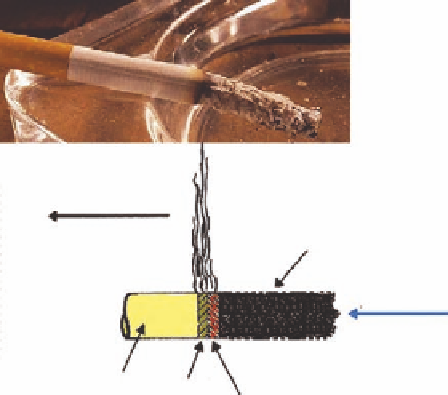Geology Reference
In-Depth Information
Propagation
Char and residue
Air flow
Porous fuel
Pyrolysis
Oxidation
Figure 17.1.4. Structure of a one-dimensional reaction front in forward smoldering, correlated with a burning
cigarette. Photo and illustration by Guillermo Rein, 2006 (Rein, 2009).
trailing edge of the burning cigarette, where the oxygen supply is available from the surrounding environment,
and the heat released is transferred ahead of the front into the virgin fuel and pyrolysis front to drive the
propagation.
Smoldering-Coal Fires
S
moldering fires of coal can burn in shallow or deep fronts. Each has different dynamics. A shallow front burns
near the free surface and is open to the atmosphere, thus having large supplies of oxygen available but exposed to
convective heat losses. A deep subsurface fire burns many meters below the ground, and thus has a limited supply
of oxygen but is insulated from heat losses to the atmosphere.
The primary three controlling mechanisms of subsurface smoldering fires are the net fuel load, the flow of
oxygen, and the heat losses. The net fuel load is dictated by the amount of carbon content per unit volume
and enhances ignition and spread. Thus the water and inert contents hinder spread. Porosity affects the bulk
density and this in turn affects the process. In general, the larger the bulk density the lower is the spread rate
and the higher the temperature. The oxygen transport enhances the spread. In porous coal beds, it is
predominantly by diffusion and dictated by the distance to a free surface and the permeability of the
medium. Porous beds of lower flow permeability offer larger transport rates of oxygen. The presence of
cracks or channels increases the transport of oxygen to feed the smoldering front and thus results in higher
spread rates and temperatures. Coal fires are fed by small quantities of air flowing through fractured strata,
cracks, natural networks, openings, or mines shafts and galleries, which permit oxygen to circulate to the
subsurface. The heat
losses hinder the spread. These are predominantly by water evaporation and heat
conduction.
The reduced heat losses of underground coal deposits, together with the high fuel availability and the small oxidizer
flows, promote long-term smoldering combustion and allow for creeping but extensive propagation both in depth
and in area. These fires prove difficult to be detected and frustrate most efforts to be extinguished. Little technical
research has been undertaken on the subject and as a result, the understanding of how to tackle these fires is very
limited (Hadden and Rein, 2010).
The effects of smoldering fires on the landscape can range from small areas (pockets of burning in superficial
layers), to large areas (burning of a hilltop). The changes to the soil and rocks produced by smoldering fires are
driven by two factors: the loss of mass and the enhanced heating. Mass loss at surface layers leads to enhanced



